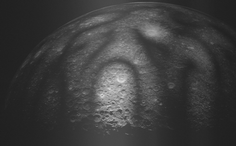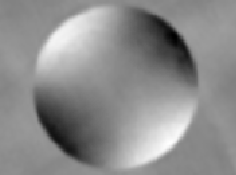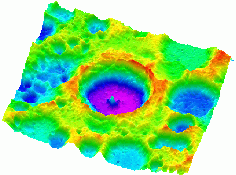Lunar Ice

|
There has been significant debate over the issue of the possible existence of ice in permanently shadowed craters at the lunar poles. The analysis of recent Earth-based radar data of the lunar polar regions should constrain the possible scattering mechanisms and may indicate whether ice is responsible for the observed radar signatures. This radar image of the Moon was obtained by receiving Arecibo-transmitted signals with the VLBA antenna in St-Croix. Similar images were obtained simultaneously at the DSS-24 tracking station in Goldstone, California. Once fully processed, these data are expected to yield the highest resolution images of the lunar south pole ever obtained (30 meters). This work was performed in collaboration with Drs. Donald Campbell, Raymond Jurgens, and Martin Slade. |
Lunar Topography
|
My thesis work consisted in measuring the unknown topography at the Lunar poles with Earth-based radar interferometry techniques. It made use of the Deep Space Network and provided maps at ~100 meter spatial and ~50 meter height resolutions. Shown here is a digital elevation model of Tycho Crater based on the radar data. We have obtained digital elevation models as well as radar imagery over extended areas (300 km by 1200 km) at the Lunar poles. The maps have absolute elevation levels with respect to a known reference ellipsoid. We used the digital elevation models of the lunar polar regions to contribute to investigations related to the possibility of ice deposits on the Moon. The maps have been used to determine the location and extent of areas which are in permanent shadow from the Sun. The maps have also been used to plan the impact of the Lunar Prospector spacecraft in a crater near the south pole of the Moon. A summary of my thesis work on "Lunar Topography from Earth-based Radar Interferometric Mapping" can be found in the abstract and preface of my Ph.D. dissertation. This work was performed in collaboration with Drs. Donald Campbell, Raymond Jurgens, and Martin Slade. |
Lunar Dielectric Constants

|
Another project deals with thermal emission measurements of the Moon using the Very Large Array. The polarization measurements obtained with the VLA were used to determine lunar dielectric constants and bulk densities. The goal was to combine this data with high resolution radar data in order to better constrain scattering models of the lunar surface.
This work was performed in collaboration with Drs. Donald Campbell, Bruce Campbell, and Bryan Butler. |
jlm@ess.ucla.edu

